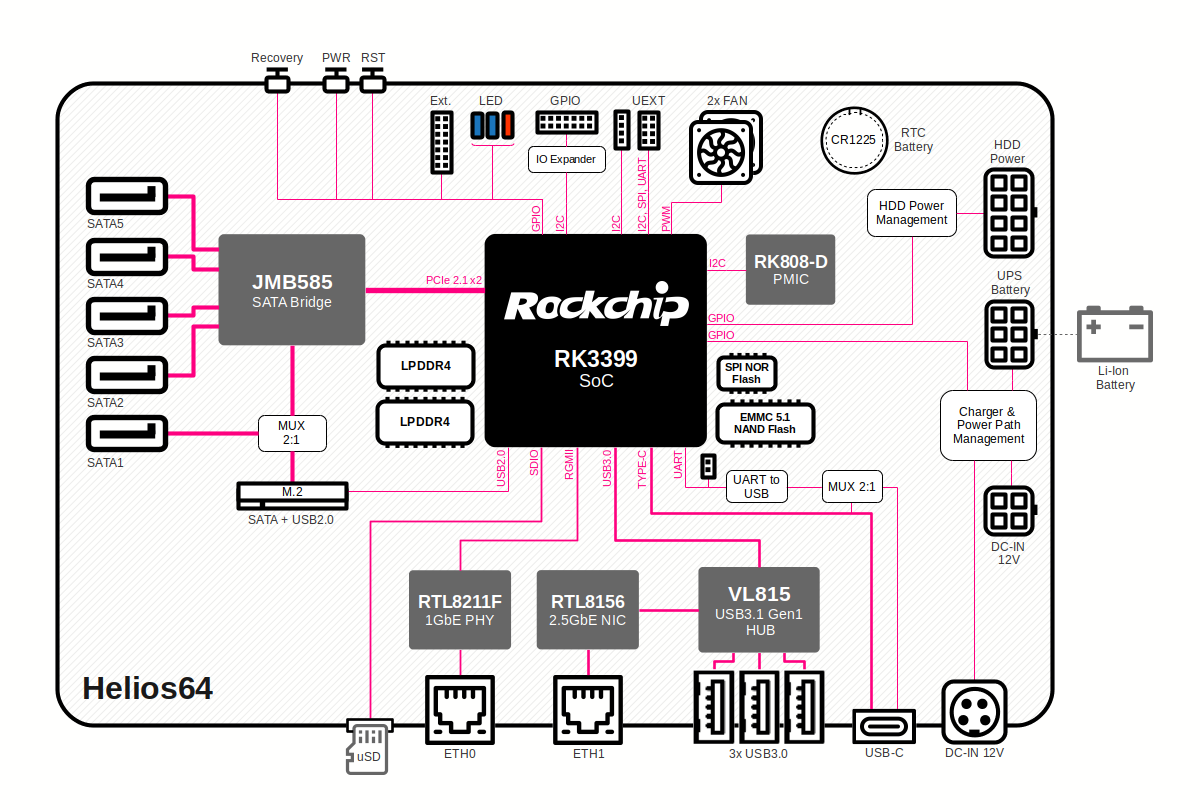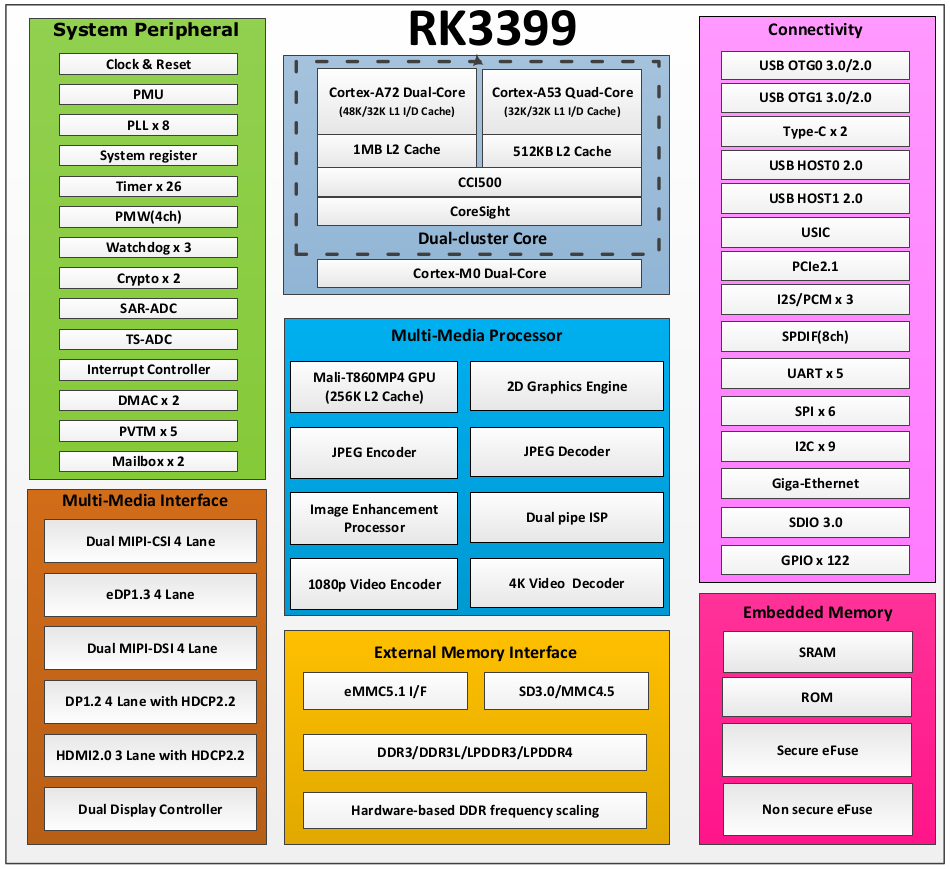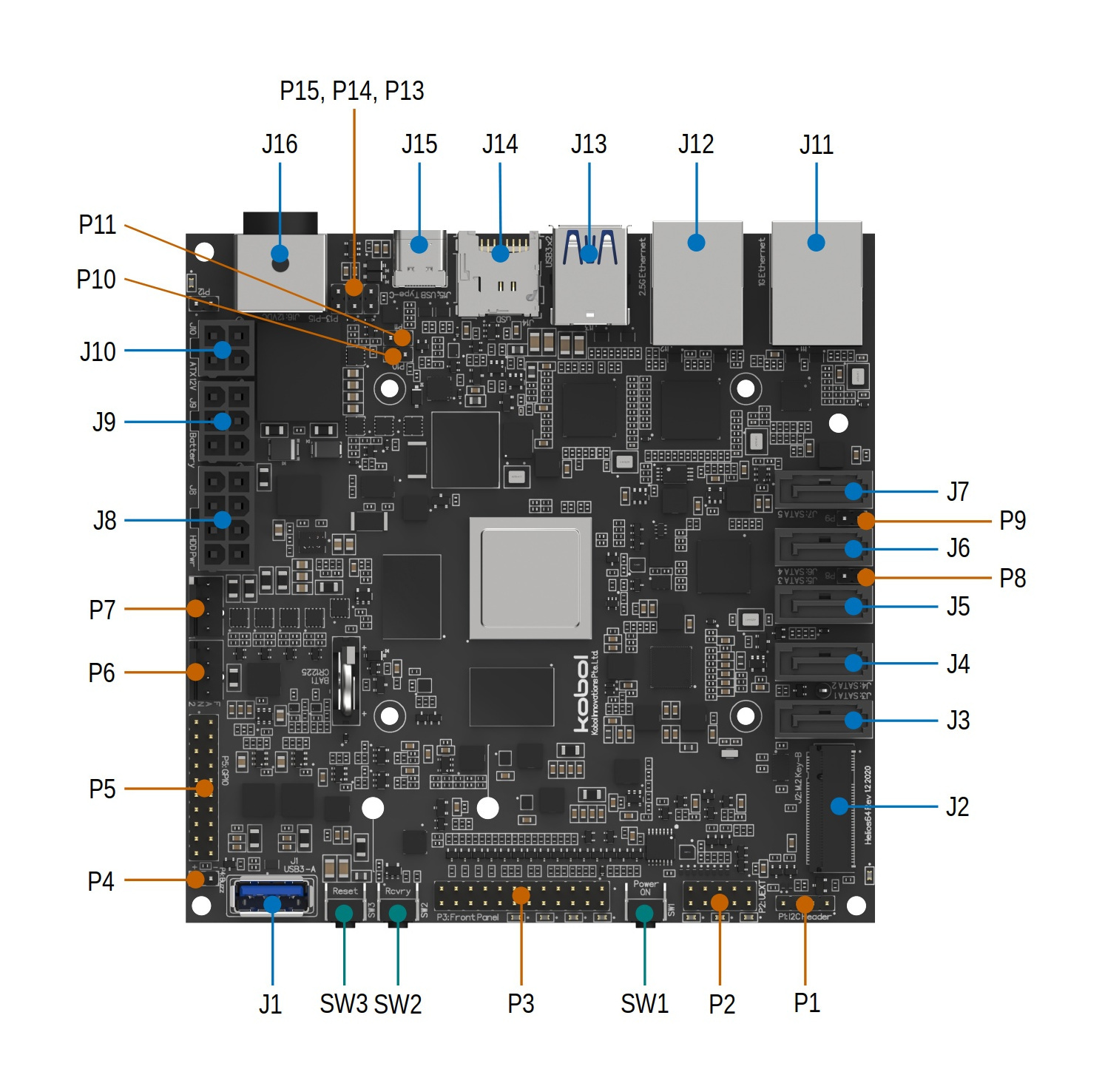Helios64 Overview¶
Block Diagram¶
Helios64 Board¶
RK3399 System-On-Chip¶
This block diagram is cited from the RK3399 website documentation. 1
Connector / Interface List¶
| Name | Peripheral Type | Connector Type | Details |
|---|---|---|---|
| J1 | USB 3.0 | USB 3.0 Type-A | USB 3.0 Port 3 |
| J2 | M.2 | M.2 Key-B | M.2 Slot for SATA SSD or USB 2.0 Device |
| J3 | SATA | SATA 3.0 | Port 0 (SATA1) |
| J4 | SATA | SATA 3.0 | Port 1 (SATA2) |
| J5 | SATA | SATA 3.0 | Port 2 (SATA3) |
| J6 | SATA | SATA 3.0 | Port 3 (SATA4) |
| J7 | SATA | SATA 3.0 | Port 4 (SATA5) |
| J8 | HDD Power | 8 Pin Mini-Fit Jr | HDD Power 5V + 12V (supports 5x HDD) |
| J9 | UPS Battery | 6 Pin Mini-Fit Jr | UPS Battery Power |
| J10 | ATX PSU | 4 Pin Mini-Fit Jr | DC input 12V |
| J11 | LAN1 | RJ45 | Gigabit Ethernet |
| J12 | LAN2 | RJ45 | 2.5 Gigabit Ethernet |
| J13 | USB 3.0 (x2) | Dual USB 3.0 Type-A | USB 3.0 Port 1 and 2 |
| J14 | microSD | Push-Push card connector | Support SDHC and SDXC |
| J15 | USB Type-C | USB Type-C Connector | Supports following: - DisplayPort Mode - DAS Mode - Host Mode - Serial Console |
| J16 | AC Adapter | Kycon 4-Pin Mini-DIN | DC input 12V |
| P1 | I2C | 4x1 Pin Header | I2C Bus |
| P2 | UEXT | 2x5 Pin Header | Universal EXTension (I2C, SPI and UART) |
| P3 | Front Panel | 12x2 Pin Header | Front Panel Extension |
| P4 | Buzzer | 2x1 Pin Header | Buzzer Alarm Speaker |
| P5 | GPIO | 7x2 Pin Header | User Configurable GPIO |
| P6 | PWM Fan | 4x1 Pin Header | Fan 1 with PWM support |
| P7 | PWM Fan | 4x1 Pin Header | Fan 2 with PWM support |
| P8 | SATA Ctrl. Programming | 2x1 Pin Header | SATA Controller Flash Enable |
| P9 | eFuse Programming | 2x1 Pin Header | eFuse Power Supply Enable |
| P10 | eMMC Flash Disable | 2x1 Pin Header | Disable eMMC |
| P11 | SPI Flash Disable | 2x1 Pin Header | Disable SPI Flash |
| P12 | Battery Configuration | 2x1 Pin Header | unpopulated |
| P13 | USB Console/Recovery Mode | 2x1 Pin Male Header | USB-C HS Mode |
| P14 | UART Debug | 2x1 Pin Male Header | UART 2 Debug |
| P15 | ATX Priority Jumper | 2x1 Pin Male Header | ATX Supply Priority |
| SW1 | Power Button | Push Button | Power Button |
| SW2 | Recovery Button | Push Button | Recovery Button |
| SW3 | Reset Button | Push Button | Reset Button |
Power Consumption¶
Board only
| State | DC measured power consumption |
AC calculated power consumption |
Remarks |
|---|---|---|---|
| Idle | 5.4 W | 6.2 W | |
| CPU Load | 10.8 W | 12.4 W | stress-ng (all cores) |
Full Kit (with 5x HDDs)
| State | DC measured power consumption |
AC calculated power consumption |
Remarks |
|---|---|---|---|
| Idle | 25.2 W | 29 W | |
| Suspend | 8.4 W | 9.7 W | Suspend-to-RAM, HDD in Standby mode |
| CPU Load | 31.2 W | 35.9 W | stress-ng (all cores) |
| HDD Read | 36 W | 41.4 W | dd read (no caching) from RAID6 array |
| HDD Write | 34.8 W | 40 W | dd write (no caching) to RAID6 array |
| Network Access | 33.6 W | 38.6 W | HTTP download from RAID6 array |
| Stress Test | 40.8 W | 47 W | stress-ng (all cores) + fio (all disks) + iperf |
Note
Measures were done using a Current Clamp Meter on the Helios64 12V DC input. AC Power consumption is calculated based on a AC/DC conversion efficiency of 85%.
- Meter tool : Extech 380942 - 30A True RMS AC/DC Mini Clamp
- AC/DC Adapter : 12V 10A (efficiency : 85%)
- HDD: 5x Toshiba P300 1TB (HDWD110) configured as RAID6
- Network : Connected at 2500Mb/s
- Fan : Medium speed (PWM 100)
- Battery : Charge status 100%
- OS: Armbian Ubuntu (Bionic) Linux 4.4.213-rk3399
Power consumption depends a lot on the HDDs brand and model used.
HDD Recommendation¶
We recommend HDD which are designed for NAS (Network Attached Storage). Those NAS HDD are specially conceived for reliable 24/7 operation and offers lower power consumption and dissipation, less vibration and noise, and finally better warranty. We recommend the following brands / families :
- Western Digital : WD Red NAS
- Seagate : IronWolf NAS
- HGST : Deskstar NAS
- Toshiba : NAS N300
Last update: June 11, 2020


